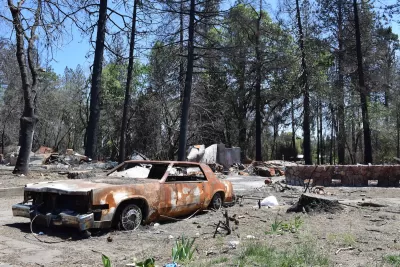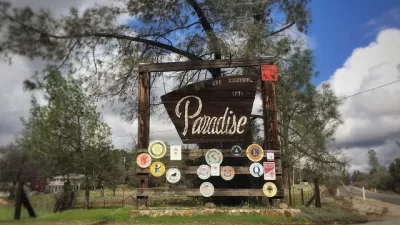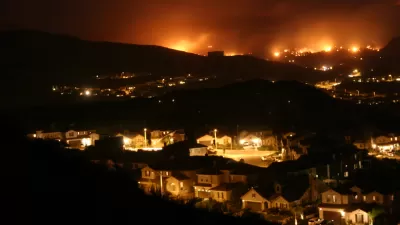The California community lost 85 lives and tens of thousands of homes. Now, high housing and rebuilding costs are forcing many former residents out.

Five and a half years ago, the town of Paradise, California burned in a devastating wildfire that killed 85 people. Today, many former residents are finding it hard to go home, displaced by deeper-pocketed transplants, wrrites Sam Mauhay-Moore in SF Gate.
“For three years in a row, data from California’s Department of Finance marks Paradise as the fastest-growing town in California. The town grew by 16.1% in 2023 (for reference, Lathrop, the state’s second-fastest-growing town, grew by only 5.4%).” And while that growth only represents 1,500 people, the change is dramatic for the small community.
“[Real estate broker Warren Bullock] puts the median price of a home in Paradise at about $450,000, a stark difference from the state’s median home price of over $900,000. But those prices are still too high for many pre-fire residents to afford, and the cost of rebuilding what they lost is also often out of reach.”
Local ordinances prohibit living in tiny houses or motor homes on residential lots, eliminating affordable housing options. Meanwhile, home insurance rates skyrocketed after the fire, a problem common across the state.
For its part, Paradise is on the road to recovery, repaving roads, undergrounding power lines, and building a new sewer line. The Camp Fire Restoration Project is using permaculture principles to restore the land in the area and make it more resilient through tree giveaways, composting workshops, soil health projects, and other efforts.
FULL STORY: In a California town destroyed by wildfire, locals are priced out by city transplants

Planetizen Federal Action Tracker
A weekly monitor of how Trump’s orders and actions are impacting planners and planning in America.

Map: Where Senate Republicans Want to Sell Your Public Lands
For public land advocates, the Senate Republicans’ proposal to sell millions of acres of public land in the West is “the biggest fight of their careers.”

Restaurant Patios Were a Pandemic Win — Why Were They so Hard to Keep?
Social distancing requirements and changes in travel patterns prompted cities to pilot new uses for street and sidewalk space. Then it got complicated.

Platform Pilsner: Vancouver Transit Agency Releases... a Beer?
TransLink will receive a portion of every sale of the four-pack.

Toronto Weighs Cheaper Transit, Parking Hikes for Major Events
Special event rates would take effect during large festivals, sports games and concerts to ‘discourage driving, manage congestion and free up space for transit.”

Berlin to Consider Car-Free Zone Larger Than Manhattan
The area bound by the 22-mile Ringbahn would still allow 12 uses of a private automobile per year per person, and several other exemptions.
Urban Design for Planners 1: Software Tools
This six-course series explores essential urban design concepts using open source software and equips planners with the tools they need to participate fully in the urban design process.
Planning for Universal Design
Learn the tools for implementing Universal Design in planning regulations.
Heyer Gruel & Associates PA
JM Goldson LLC
Custer County Colorado
City of Camden Redevelopment Agency
City of Astoria
Transportation Research & Education Center (TREC) at Portland State University
Camden Redevelopment Agency
City of Claremont
Municipality of Princeton (NJ)





























